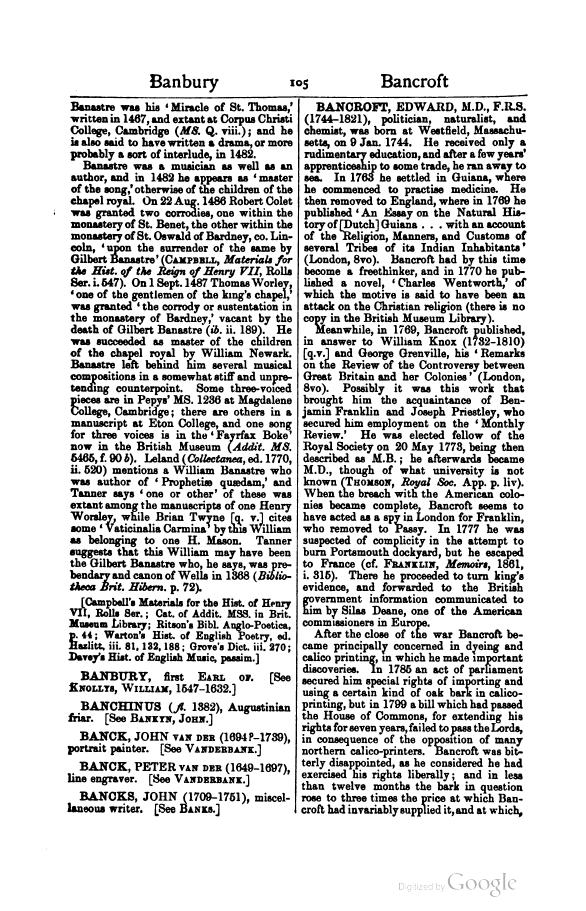Banastre was his 'Miracle of St. Thomas,' written in 1467, and extant at Corpus Christi College, Cambridge (MS. Q. viii.); and he is also said to have written a drama, or more probably a sort of interlude, in 1482.
Banastre was a musician as well as an author, and in 1482 he appears as 'master of the song,' otherwise of the children of the chapel royal. On 22 Aug. 1486 Robert Colet was granted two corrodies, one within the monastery of St. Benet, the other within the monastery of St. Oswald of Bardney, co. Lincoln, 'upon the surrender of the same by Gilbert Banastre' (Campbell, Materials for the Hist. of the Reign of Henry VII, Rolls Ser. i. 547). On 1 Sept. 1487 Thomas Worley, 'one of the gentlemen of the king's chapel,' was granted 'the corrody or sustentation in the monastery of Bardney,' vacant by the death of Gilbert Banastre (ib. ii. 189). He was succeeded as master of the children of the chapel royal by William Newark. Banastre left behind him several musical compositions in a somewhat stiff and unpretending counterpoint. Some three-voiced pieces are in Pepys' MS. 1236 at Magdalene College, Cambridge; there are others in a manuscript at Eton College, and one song for three voices is in the 'Fayrfax Boke' now in the British Museum (Addit. MS. 5465, f. 90 b). Leland (Collectanea, ed. 1770, ii. 520) mentions a William Banastre who was author of 'Prophetiæ quædam,' and Tanner says 'one or other' of three was extant among the manuscripts of one Henry Worsley, while Brian Twyne [q. v.] cites some 'Vaticinalia Carmina' by this William as belonging to one H. Mason. Tanner suggests that this William may have been the Gilbert Banastre who, he says, was prebendary and canon of Wells in 1368 (Bibliotheca Brit. Hibern. p. 72).
[Campbell's Materials for the Hist. of Henry VII, Rolls Ser.; Cat. of Addit. MSS. in Brit. Museum Library; Ritson's Bibl. Anglo-Poetica, p. 44; Warton's Hist. of English Poetry, ed. Hazlitt, iii. 81, 132, 188; Grove's Dict. iii. 270; Davey's Hist. of English Music, passim.]
BANBURY, first Earl of. [See Knollys, William (1547–1632).]
BANCHINUS. [See Bankyn, John.]
BANCK, JOHN van der (1694?–1739), portrait painter. [See Vanderbank.]
BANCK, PETER van der (1649–1697), line engraver. [See Vanderbank.]
BANCKS, JOHN (1709–1751), miscellaneous writer. [See Banks.]
BANCROFT, EDWARD, M.D., F.R.S. (1744–1821), politician, naturalist, and chemist, was born at Westfield, Massachusetts, on 9 Jan. 1744. He received only a rudimentary education, and after a few years' apprenticeship to some trade, he ran away to sea. In 1763 he settled in Guiana, where he commenced to practise medicine. He then removed to England, where in 1769 he published 'An Essay on the Natural History of [Dutch] Guiana … with an account of the Religion, Manners, and Customs of several Tribes of its Indian Inhabitants' (London, 8vo). Bancroft had by this time become a freethinker, and in 1770 he published a novel, 'Charles Wentworth,' of which the motive is said to have been as attack on the Christian religion (there is no copy in the British Museum Library).
Meanwhile, in 1769, Bancroft published, in answer to William Knox (1732-1810) [q. v.] and George Grenville, his 'Remarks on the Review of the Controversy between Great Britain and her Colonies' (London, 8vo). Possibly it was this work that brought him the acquaintance of Benjamin Franklin and Joseph Priestley, who secured him employment on the 'Monthly Review.' He was elected fellow of the Royal Society on 20 May 1778, being then described as M.B.; he afterwards became M.D., though of what university is not known (Thomson, Royal Soc. App. p. liv). When the breach with the American colonies became complete, Bancroft seems to have acted as a spy in London for Franklin, who removed to Passy. In 1777 he was suspected of complicity in the attempt to burn Portsmouth dockyard, but he escaped to France (cf. Franklin, Memoirs, 1861, i. 315). There he proceeded to turn king's evidence, and forwarded to the British government information communicated to him by Silas Deane, one of the American commissioners in Europe.
After the close of the war Bancroft became principally concerned in dyeing and calico printing, in which he made important discoveries. In 1786 an act of parliament secured him special rights of importing and using a certain kind of oak bark in calico-printing, but in 1799 a bill which had passed the House of Commons, for extending his rights for seven years, failed to pass the Lords, in consequence of the opposition of many northern calico-printers. Bancroft was bitterly disappointed, as he considered be had exercised his rights liberally; and in less than twelve months the bark in question rose to three times the price at which Bancroft had invariably supplied it, and at which,

